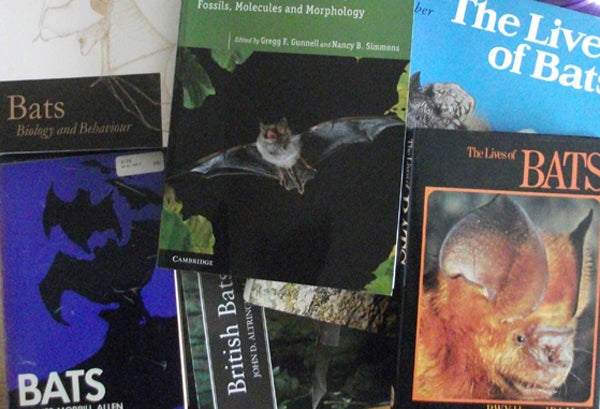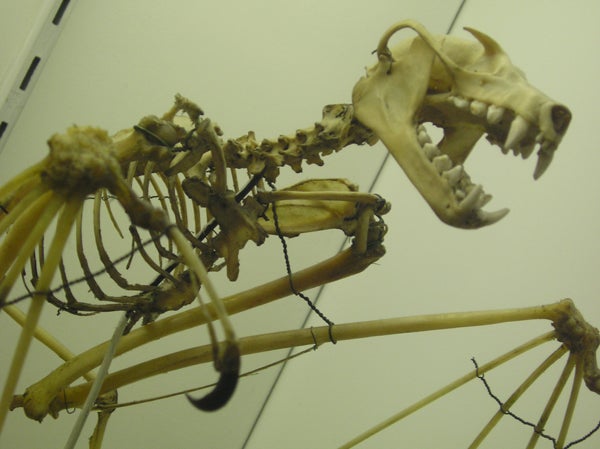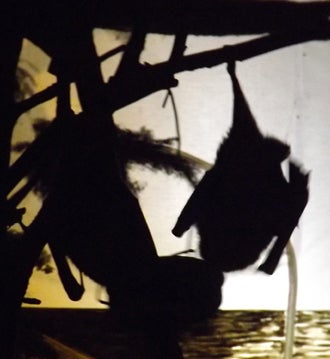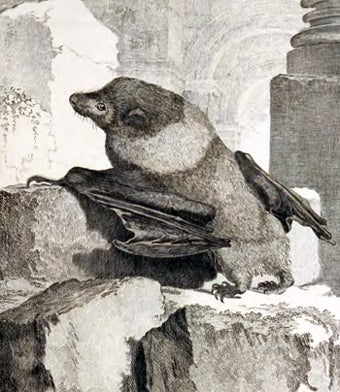This article was published in Scientific American’s former blog network and reflects the views of the author, not necessarily those of Scientific American
I’m sure I’ve said on several occasions that there are vast tetrapod groups that I’ve simply never covered in any depth at Tet Zoo – this, after 12 years of operation. It’s a disgrace.

There are quite a few really good books on bats. There are quite a few bad ones too. Here is part of the Tet Zoo bat book collection. Credit: Darren Naish
Among those are bats, one of the largest, most diverse and (I think) most interesting of mammal groups. OK, I covered vesper bats (the vespertilionids) at length some years back (oh my god, it was in 2011) (links below), but I haven’t done the group justice at all. Bats are also especially interesting in that they have an extensive fossil record, this being in part due to their useful habit of dying and decomposing in caves. Having said that their record is extensive, note that it isn’t good in terms of representing those lineages of bats that must have existed: some estimates suggest that the record is 70% incomplete (Teeling et al. 2012). Anyway, combine what we do know with the reasonable amount of work done on bat phylogeny, and we know quite a lot about some parts of bat evolutionary history. And there are lots of neat stories here, none of which are covered in those few popular books that discuss mammal evolutionary history (mentioning no names…). In what may or may not be a long-running epic, I here want to begin a multi-part series on snippets from the world of bat history. It goes without saying that all of this stuff is gleaned from The Big Book, the bat section of which is substantial. Enough preamble.
On supporting science journalism
If you're enjoying this article, consider supporting our award-winning journalism by subscribing. By purchasing a subscription you are helping to ensure the future of impactful stories about the discoveries and ideas shaping our world today.

A Pteropus fruit bat skeleton I once encountered in a Scottish museum: most likely a Large flying fox P. vampyrus. A nice illustration of how impressive the teeth are on some mammalian frugivores (as if you didn’t know this already). Credit: Darren Naish
Fruit bats, flying foxes or megabats (though, ok, these terms are not all strictly synonymous) – technically Pteropodidae – are frugivorous, large-ish bats of the Asian, African and Australasian tropics, noted for their superficially lemur-like faces (caveat: not all are large per se. Some Micropteropus and Scotonycteris species have head and body lengths of less than 6 cm). There are over 40 genera, so this is a large and diverse group. The biggest species have wingspans of 1.7 m or so.
That primate-like face has led to the appealing idea that fruit bats might be close kin of primates (Pettigrew 1986), an idea discussed here at Tet Zoo in the past but not supported by the bulk of anatomical or molecular data. Modern molecular phylogenies find fruit bats to be closest to rhinolophoids (horseshoe bats and kin), meaning that they should have a fossil record that extends back to the Eocene, since rhinolophoids do. A pteropodid tooth from the Upper Eocene of Thailand matches this prediction but good fossils of especially early members of the group are as yet unknown. The absence of laryngeal echolocation in fruit bats is most likely a derived feature – not a primitive one – given the presence of echolocating habits in the other bat lineages. Genetic data on this is ambiguous, though there’s amino acid data suggesting that fruit bats were once under the same selection pressure as goes hearing as are rhinolophoids (Teeling 2009). It’s well known that Rousettus – deeply nested within the group – practices a sort of echolocation that involves tongue-clicking. Less familiar is the recent discovery that fruit bats of some, many or even all lineages use clicks made with the wings in echolocating (Boonman et al. 2014).

I have essentially no good photos of live fruit bats. Here are some captive Comoro black or Livingstone’s fruit bats P. livingstonii. Credit: Darren Naish
There are a few weird fossil members of the fruit bat lineage from the Oligocene and Miocene, namely Archaeopteropus from Italy and Propotto from Kenya: the former might not be a fruit bat at all (but a bat of some other kind) and the latter was originally described as a primate (hence the name). Modern fruit bat genera are known as fossils from the Pliocene onwards (Eidolon of Madagascar supposedly has a Lower Pliocene record). If any of them can be considered ‘famous’, it’s Bulmer’s fruit bat Aproteles bulmarae of New Guinea.

A 1763 illustration of Pteropus subniger from Georges-Louis Leclerc, Comte de Buffon and Louis-Jean-Marie Daubenton’s volume on natural history. I love the gothic background in this illustration. Credit: Georges-Louis Leclerc, Comte de Buffon and Louis-Jean-Marie Daubenton WikiMedia
First documented as an Upper Pleistocene fossil in 1977, Aproteles was then discovered alive (though, actually, the modern specimens had been found in 1975, just not announced), then declared extinct (due to human exploitation), then rediscovered alive, then declared extinct again. It seems to be critically endangered: scattered records suggest that it might be more widespread than usually thought, but it also has a habit of disappearing from the two or three roost sites on record and, at best, persisting in numbers lower than 200. Declines caused by human hunting are not unique to this species: fruit bats have been hit especially hard by people on the islands of the South Pacific and Indian oceans and various populations are extinct as a result. The Rougette, Lesser Mascarene flying-fox or Dark flying fox Pteropus subniger of Réunion and Mauritius – hunted to extinction sometime around 1860 – seems to have been an especially interesting fruit bat since it was relatively cool-tolerant, roosted in caves and hollow trees, was semi-nocturnal, and has jaw and skull features indicating a more variable diet than typical for its group (Cheke & Hume 2008).
I need to cover fruit bats at length some time. More bats again sometime soon.
For previous Tet Zoo articles on bats, see...
Introducing the second largest mammalian ‘family’: vesper bats, or vespertilionids
Bent-winged bats: wide ranges, very weird wings (vesper bats part III)
The many, many mouse-eared bats, aka little brown bats, aka Myotis bats (vesper bats part V)
Long-eared bats proper: Plecotus and other plecotins (vesper bats part VI)
Robust jaws and a (sometimes) ‘greenish’ pelt: house bats (vesper bats part IX)
Antrozoins: pallid bats, Van Gelder’s bat, Rhogeessa… Baeodon!! (vesper bats part XI)
Putting the ‘perimyotines’ well away from pips proper (vesper bats part XII)
Eptesicini: the serotines and their relatives (vesper bats part XIV)
Hypsugines: an assemblage of ‘pipistrelle-like non-pipistrelles’ (vesper bats part XV)
Books of the TetZooniverse: of Palaeoart, Bats, Primates and Crocodylians
Refs - -
Boonman, A., Bumrungsri, S. & Yovel, Y. 2014. Nonecholocating fruit bats produce biosonar clicks with their wings. Current Biology 24, 2962-2967.
Cheke, A. & Hume, J. 2008. Lost Land of the Dodo. Yale University Press, New Haven and London.
Pettigrew, J. D. 1986. Flying primates? Megabats have the advanced pathway from eye to mid-brain. Science 231, 1304-1306.
Teeling, E. C. 2009. Hear, hear: the convergent evolution of echolocation in bats? Trends in Ecology and Evolution 24, 351-354.
Teeling, E. C., Dool, S. & Springer, M. S. 2012. Phylogenies, fossils and functional genes: the evolution of echolocation in bats. In Gunnell, G. F. & Simmons, N. B. (eds) Evolutionary History of Bats: Fossils, Molecules and Morphology. Cambridge University Press (Cambridge), pp. 1-22.